Venezuela Bids Farewell to Last Glacier, Wrapped in Plastic
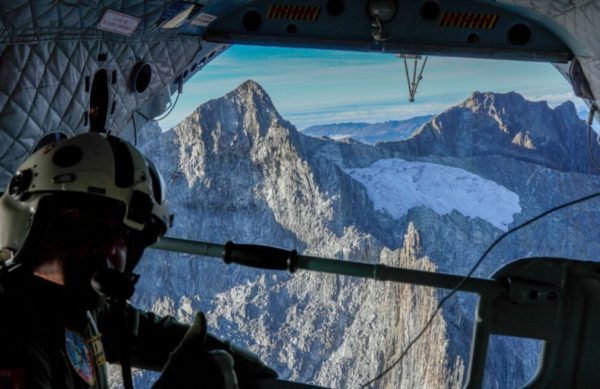
HAVANA TIMES – Venezuela has undertaken the task of covering the remains of its last glacier, La Corona, on Humboldt Peak at 4,900 meters above sea level in the Andes mountains in the southwest of the country, with plastic “blankets” to slow the inevitable end of this icy patch of its mountain landscape and source of legends.
“We are not going to change the rhythm of nature, but we’re trying to curb the loss of the strip of glacier that we have left, for research and contributions that can be useful for other Andean countries where glaciers are also receding,” Toro Belisario, director of the Ministry of Ecosocialism (Minec) in the southwestern Andean state of Mérida, told IPS.
“A couple of dying hectares is all that remains of the nearly 1,000 hectares of glaciers that Venezuela had in the Sierra Nevada de Mérida at the beginning of the 20th century. They are the first victims of global warming.” — Julio César Centeno
The 1.8-hectare remains of the glacier will be covered with 80-meter-long polypropylene geotextile “blankets” brought from Italy in 35 rolls weighing 80 kilos each, which will be lifted by armed forces helicopters to the camp on the Humboldt Peak.
Some academics are opposed to the project, claiming that it has not been properly studied and that it is a vain effort to resist climate change and poses environmental risks for mountain species and rural and urban communities that could be polluted by plastic waste.
Belisario acknowledged that at the rate at which the glacier is retreating, one hectare per year, it has little life left, under the burden of climate change and the impact of the El Niño weather phenomenon blowing warm winds over the Pacific Ocean that alter the temperature in the region.
On the other hand, he defended the usefulness of the data that the initiative and its monitoring can provide month after month, for Venezuela and neighbors such as Peru, where numerous communities depend on glaciers as a source of water.
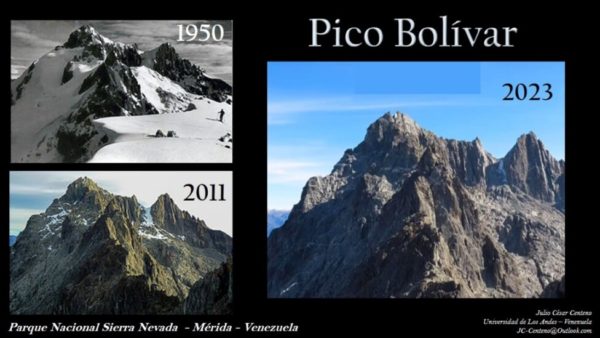
Environmental expert Julio César Centeno, a professor at the University of the Andes (ULA) in Mérida, told IPS that “the most that can be expected from the initiative is to prolong for a couple more years the final ordeal of the tiny, dying portion of the glacier that remains.”
Centeno and other ULA researchers warned in a press release that “it could cause environmental and ecological damage to the glacier and surrounding areas of the Andes highlands, as well as potentially affecting neighboring populations, due to air and water pollution from micro and nano plastics.”
The criticism asserts that Minec has failed to comply with current legislation, in terms of broad and informed consultation with local communities, presentation of an environmental impact study available to the public, and working together with concerned institutions, such as the university.
A century of retreat
“A couple of dying hectares is all that remains of the nearly 1,000 hectares of glaciers that Venezuela had in the Sierra Nevada de Mérida at the beginning of the 20th century. They are the first victims of global warming,” Centeno said.
This mountain range is in the center of the Venezuelan Andes – a 450 kilometer mountainous strip – with “perpetual snow” on its high peaks, Bolivar – 4978 meters above sea level, the highest in the country – La Concha, Toro, Humboldt and Bonpland.
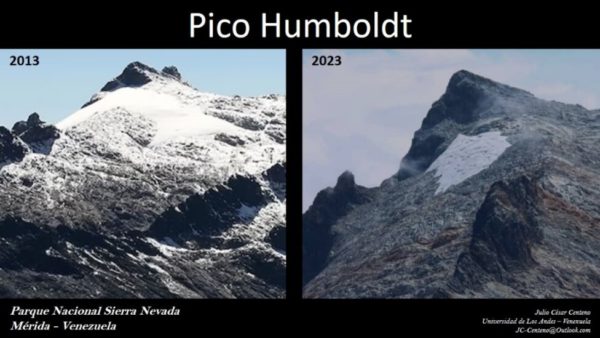
All of them have shrunk over the years, but in 1956 a national ski championship was held in the mountains. However, at the end of the last century only the La Corona glacier remained, on the Humboldt Peak, which with 400 hectares had also covered part of the Bonpland mountain, before losing 99.7 percent of its original extension.
Centeno explained that in countries such as Germany, Austria, France, Italy and Switzerland, glaciers are being covered with plastic blankets to reflect solar radiation and reduce energy absorption, but only during the summer months and especially in ski resorts. The costs are charged to the users.
There are also cases in Chile, China and Russia, and in most cases the glaciers to be covered are not only in latitudes far from the tropics but at lower altitudes than in Mérida, with more exposure to wind, sun and rain, which provide harsher conditions for the geotextile coverings.
This led ULA experts to warn of greater risks of deterioration of the tarps, and ruptures or tears leading to the spread of micro and nano plastics that the air and water would carry to agricultural and urban communities, such as the city of Mérida at the foot of the Sierra, with a population of around 300,000 people.

Five white eagles
Since its foundation in 1558, the city has had a close relationship with its snow-capped mountains, ranging from enraptured contemplation to the utilitarian source of income provided by the highest cable car in the world, reaching from the city to 4765 meters above sea level in the Sierra.
In literature, the best-known reference is “The Five White Eagles”, which dates back to 1895, in which the humanist Tulio Febres Cordero (1860-1938) wrote down a legend of the Mirripuyes Indians, one of the groups that lived in the area when the Spaniards arrived in the sixteenth century.
The legend has it that five huge white eagles with silver wings flew over the mountains and Caribay, the first woman, daughter of the sun and the moon, fell in love with them and wanted the birds’ feathers to adorn her head.
Caribay ran along the ridges chasing the shadows of the birds but, when she was about to reach them, the eagles dug their talons into the cliffs and turned to stone, forming the five masses of ice that crowned the Sierra.
Since then, according to the legend, the occasional snowfalls are simply the awakening of the eagles, and the whistling of the wind in the highlands is an echo of the sad, monotonous song of Caribay as she fails to reach her silver trophy.
The governor of the state of Mérida, Jehyson Guzmán (R) receives the rolls of polystyrene, purchased in Italy, with which the La Corona glacier will be partially covered. Environmental academics are alert to the risk of eventual deterioration becoming a source of plastic pollution. CREDIT: Harrison Ruiz / Minec
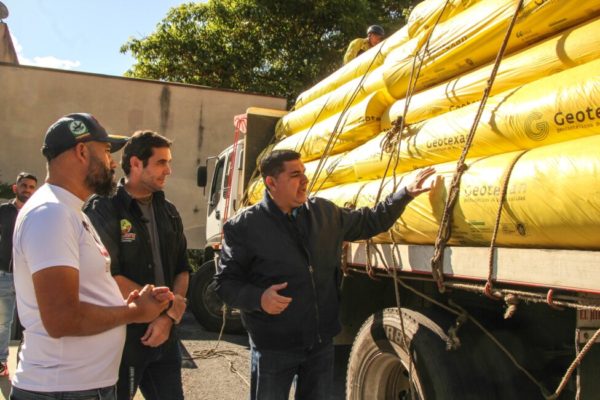
Political presence
In justifying the plastic blanket project, Belisario said that “because of what this legend represents for the cosmovision of people from Mérida, we must not allow the glacier to disappear without contributing what we can to its study, and to the mitigation and adaptation to climate change.”
Centeno lamented that the eagles “no longer flap their wings, and their feathers no longer glitter. We all believed that because of their grandeur they were indestructible. They were swallowed by human indifference.”
In conversation with IPS, Ana Medina, a high school teacher in Mérida, and Yajaira Méndez, a shopkeeper in the municipal market, agreed that at home young people “must have once studied the legend of the white eagles” but that they are hardly aware of the end of the glacier.
“The people of Mérida love their mountains but have no information, and the glacier covering is not a topic that is talked about on a daily basis,” Euro Lobo, a veteran journalist in the city, told IPS.
Centeno said there may be political interest, in this year in which the country will hold a presidential election and it is expected that the current President Nicolás Maduro will seek reelection for a third six-year term.
“Perhaps the government wants to show that it is interested in saving as much as possible of the jewel that represents the last glacier for the city and the country,” said Centeno.
This monument to the Five White Eagles is on the outskirts of the city of Mérida. A legend written down in the late 19th century by writer Tulio Febres Cordero is a cultural icon. CREDIT: Samuel Hurtado / IAM Venezuela
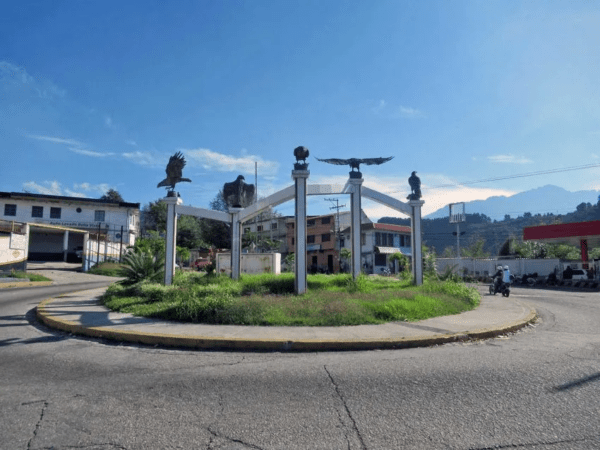
Operation Protection
The governor of the state of Mérida, Jehyson Guzmán, of the ruling United Socialist Party of Venezuela, and General Ruben Belzares, the area’s military chief, announced on Feb. 21 that the new phase of the “Operation Protection of the Humboldt Peak Glacier” began.
“This is about rescuing the last glacier in Venezuela, the last stretch of ice that nature donated in its landscapes to the Mérida territory. We are involved in the struggle to rescue, preserve and maintain it as far as possible,” said Belzares.
He pointed out that a helicopter has been prepared to transport material and equipment, and reconnaissance flights have been carried out near the summit.
Guzmán said that the first camp has been set up and its 26 members are ready to begin work as soon as weather conditions permit, since there was unusual snowfall for the end of February.
Since December the region has had high temperatures, “generating higher pressure on the glacier. That is why the deployment is important, because at this accelerated rate of heat at the end of the year we may not have any glacier left,” said Guzmán.
He reported that in the Sierra Nevada all types of burning and logging have been prohibited, as well as climbing with spiked shoes.
He also specified that the geotextile blankets will not be placed directly on the entire glacier, but in the surrounding areas where the ice sheet is weakening, where melting has been the most accelerated.
The final flapping of the wings of the last of the eagles will occur under a polystyrene blanket.





